Take a walk through a gallery of wearable art. The jewelry items gathered here were selected for
qualities that make them more like artistic statements than simple accessories. These
qualities may be bold combinations of color, intriguing shapes, both, or something else
entirely. These pieces may not always be the easiest to wear, but they are generally the
most striking.
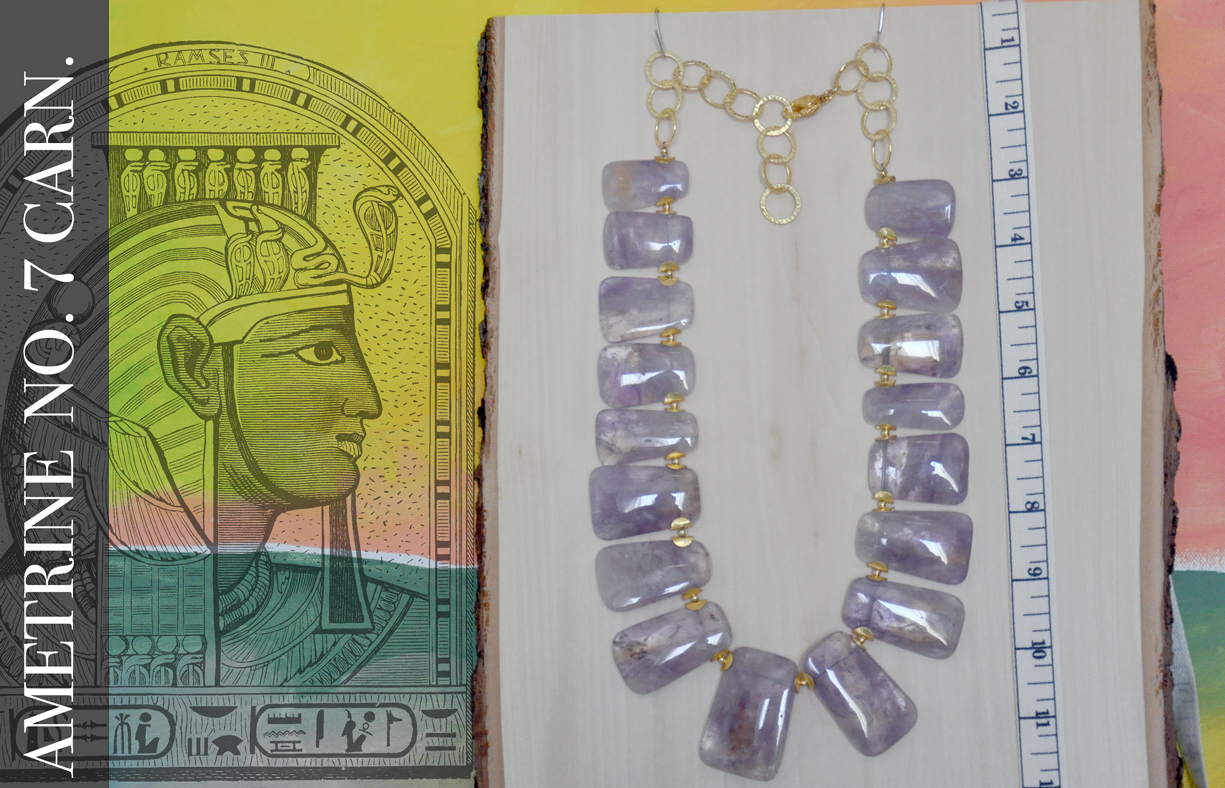
AMETRINE NO. 7 CARNARVON. Ametrine contains both amethyst and citrine, and the gemstones show intriguing transitions between the purple and
golden yellow colors of these gemstones. The large top-drilled rectangles in this necklace form a large,
gracious collar, much like ornaments depicted in Egyptian art. The English peer and aristocrat helped financed the famous
search and excavation of Tutankhamun's tomb in 1922.
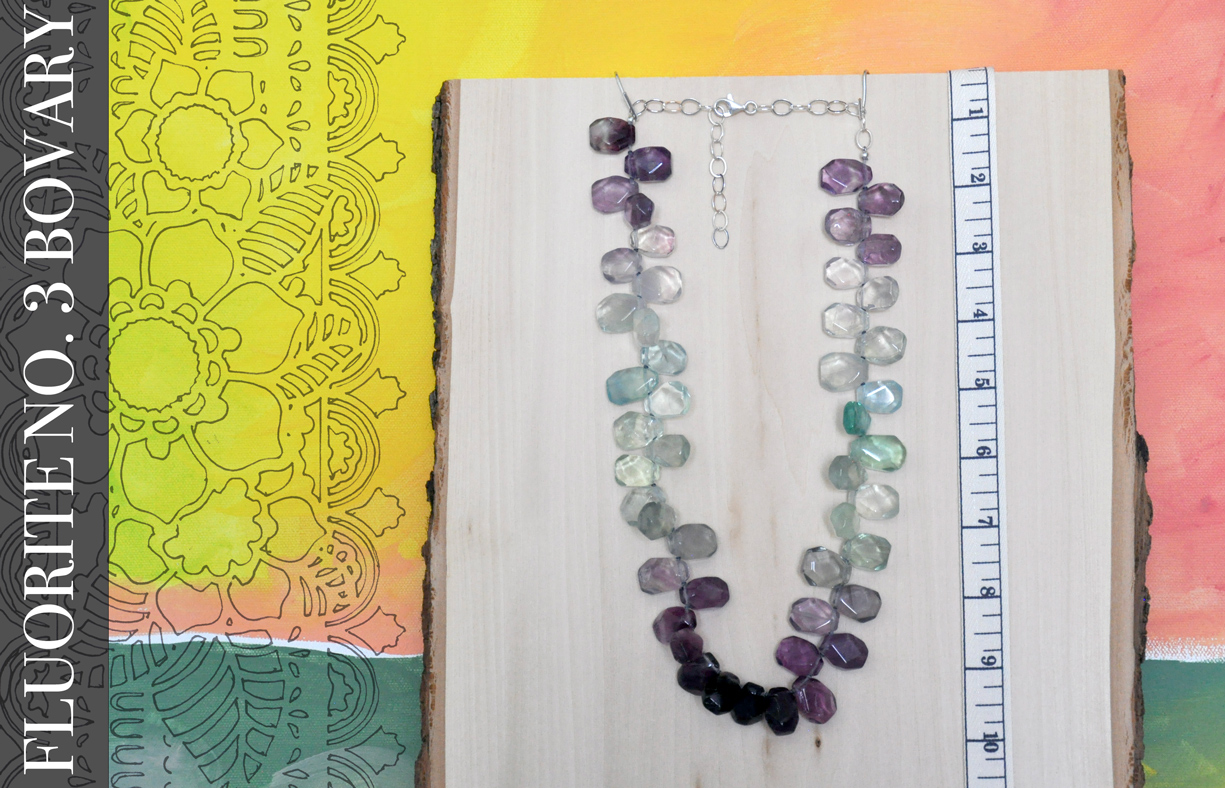
FLUORITE NO. 3 MADAME BOVARY. The colors in this unusual necklace flow from lavender to icy teal blue to
deep purple, thanks to fluorite nuggets. This gemstone comes from the Latin word "fleure," which relates to
flowing out or continuous change. Madame Bovary might appreciate this bold design in her quest of a different
life, flowing with beauty and meaning.
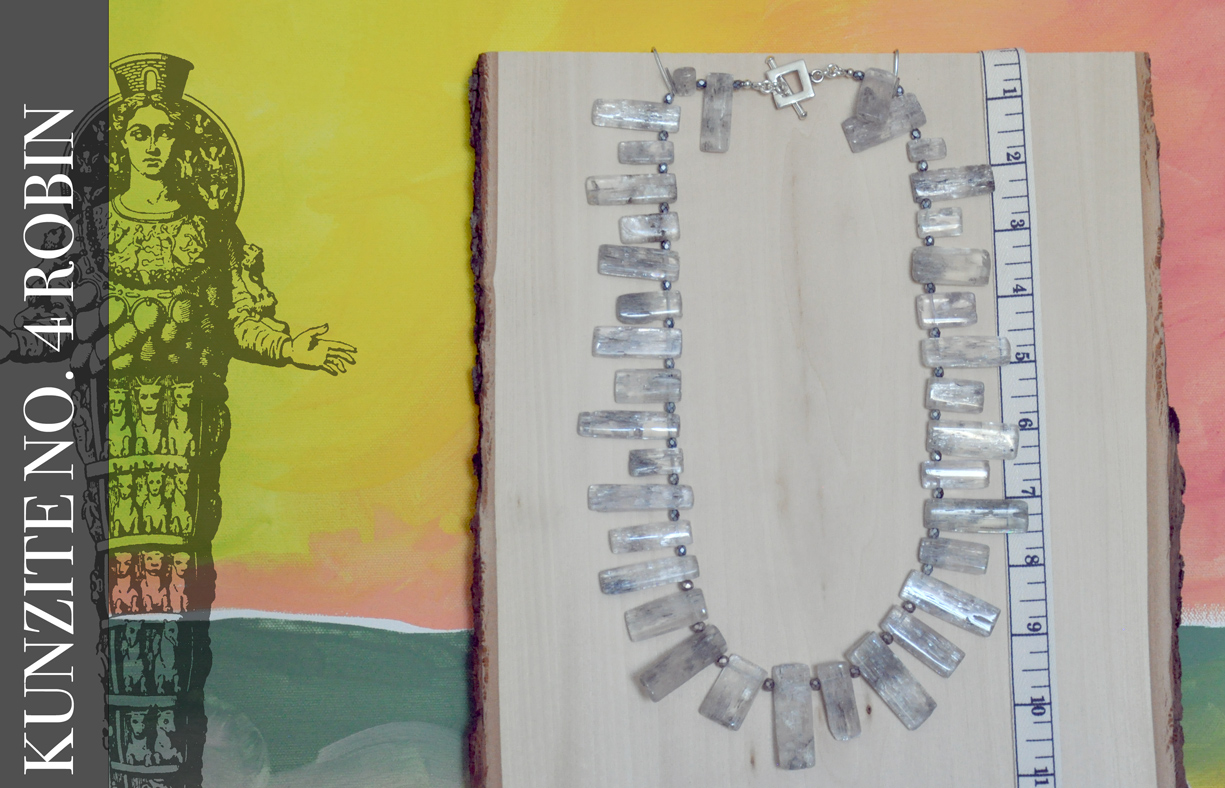
KUNZITE NO. 4 ROBIN GOODFELLOW. Kunzite is gem-quality pink to lavender spodumene, a lithium aluminosilicate. The intriguing
columnar crystals show the texture typical of the gemstone, and the errant patterns are like the energy from that
unpredictable Puck.
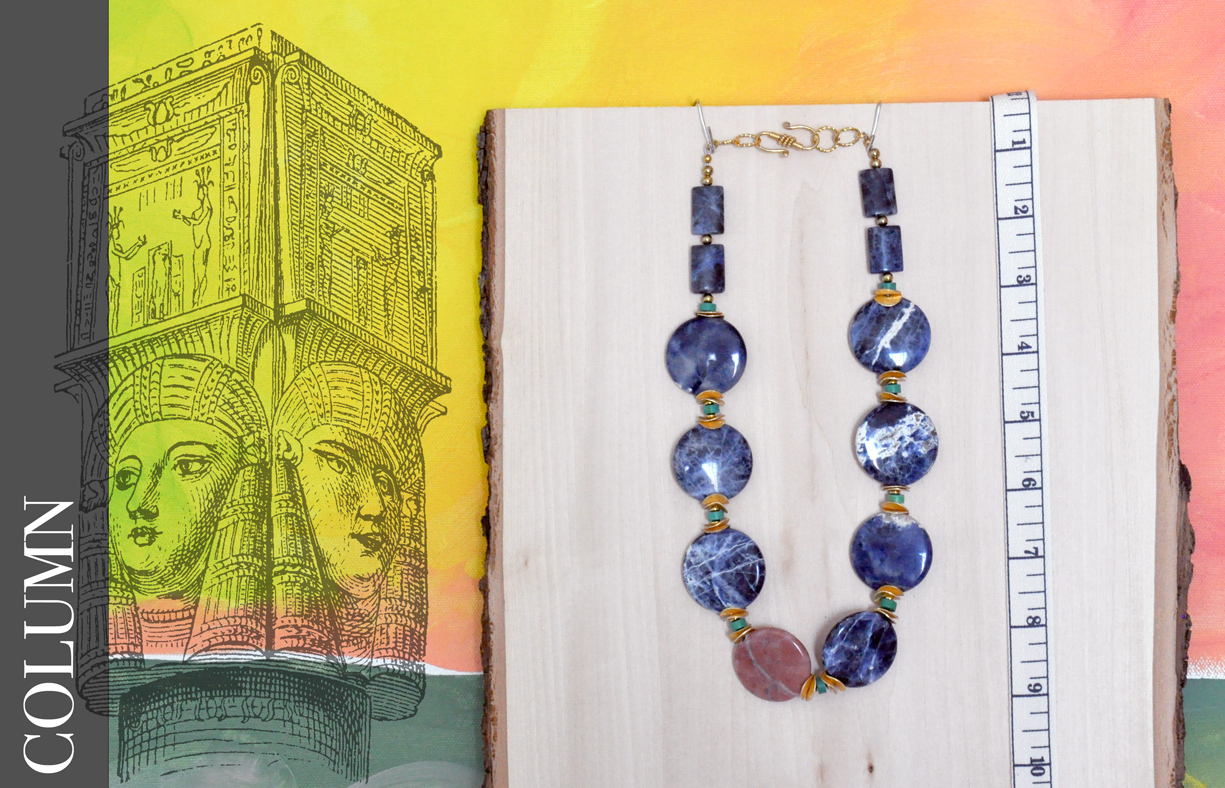
COLUMN. Large sodalite gemstone coins with a central orange red moukaite coin form a decorative
collar circling the neck of the wearer. Stand stately like a column with this strong necklace trimmed with
gold.
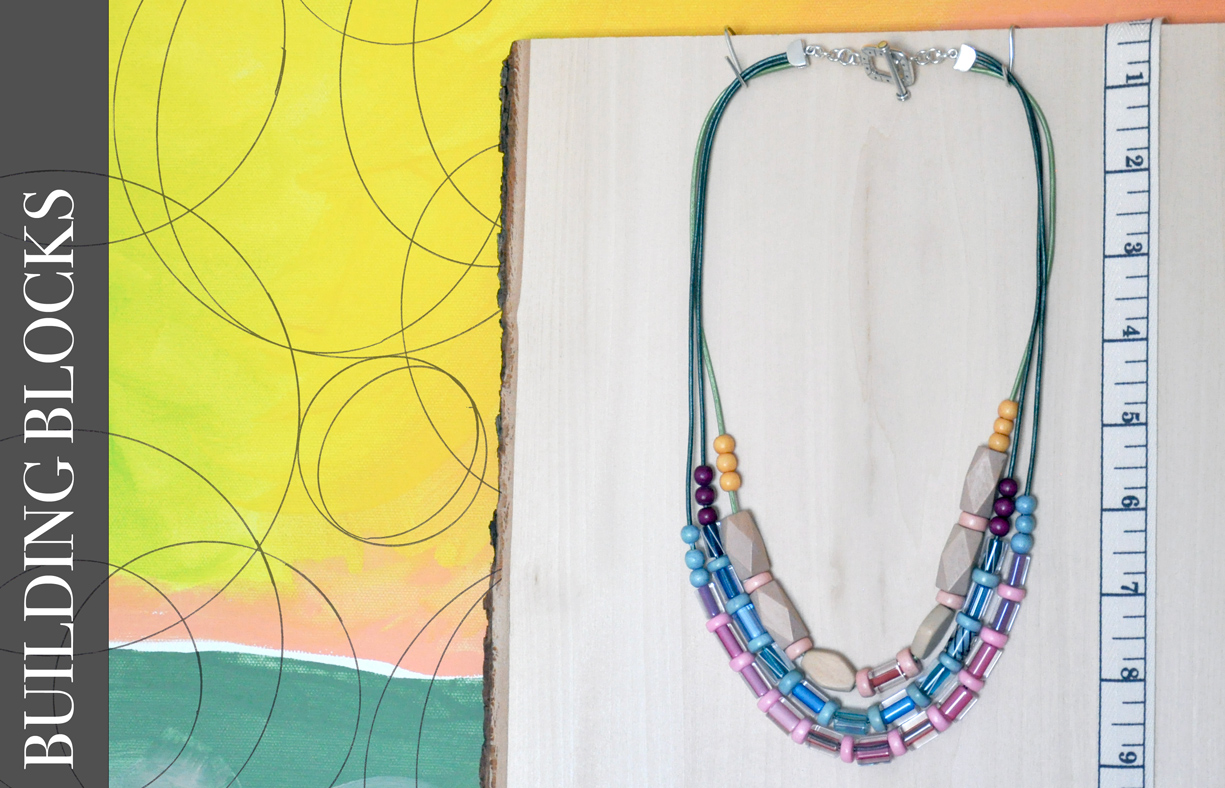
BUILDING BLOCKS. Each strand builds on the other in this colorful necklace with brightly colored furnace
glass and wooden beads. Furnace glass, or cane glass, refers to pieces created by pulling heated glass into
long uniform canes that contain the pattern within the original glass.
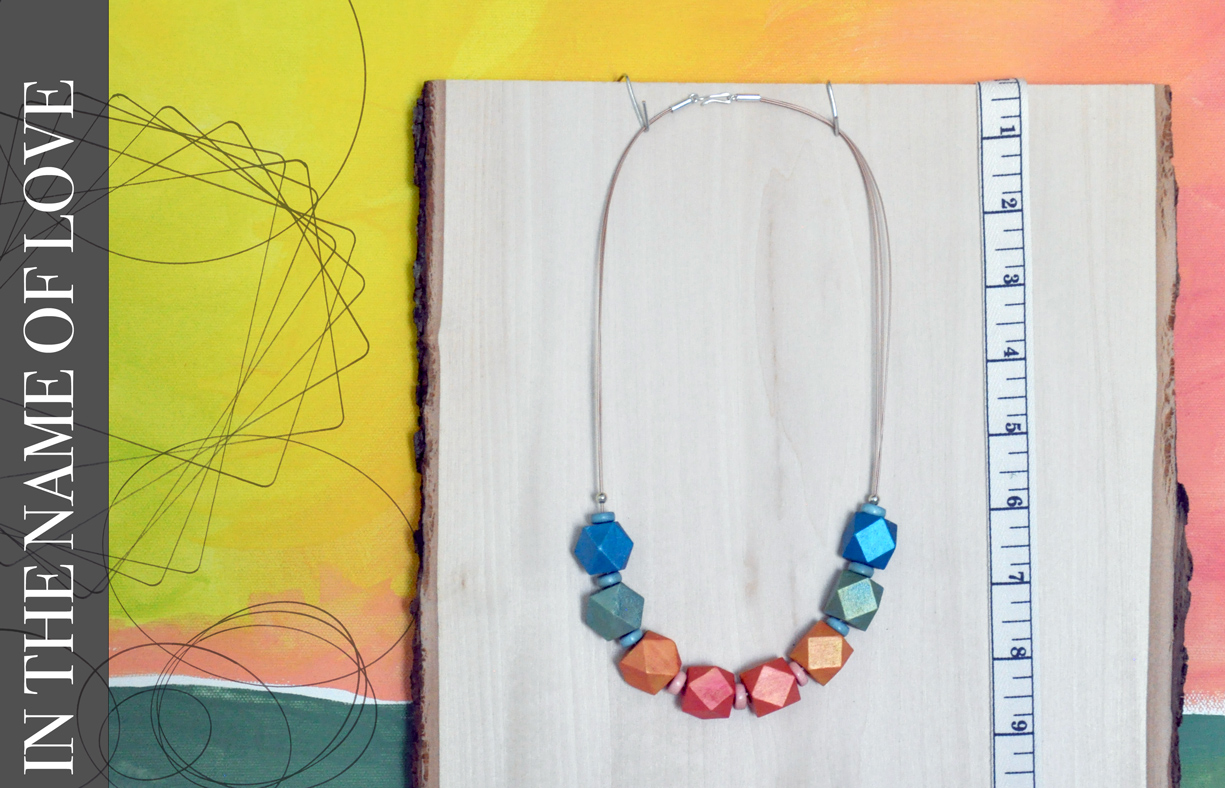
IN THE NAME OF LOVE. Brightly painted wooden nuggets shimmer in this colorful necklace
celebrating all love. The wooden nuggets are plain hardwood from Asia, approximately 3/4"
in size.
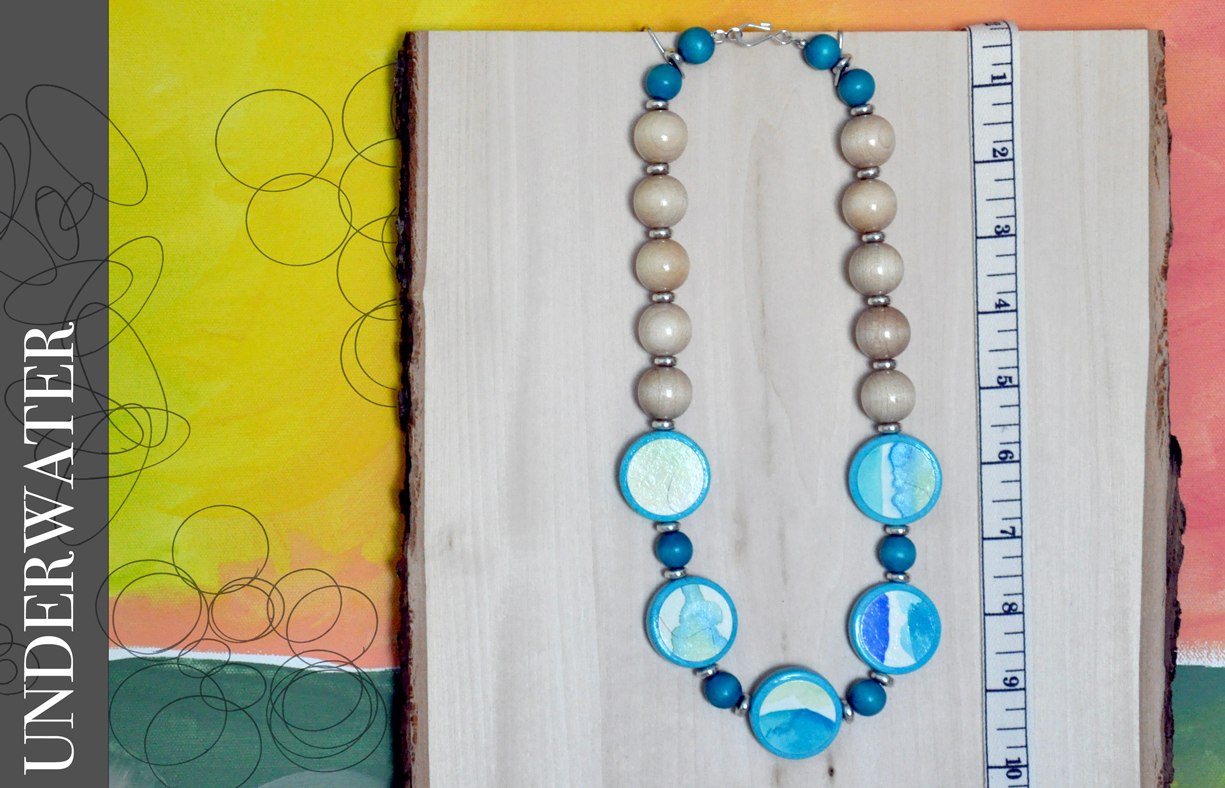
UNDERWATER. Large wooden round beads form the base of the artistic necklace featuring turquoise colored chalk
coins with flowing designs on watercolor paper. Chalk turquoise has similar composition to turquoise but lacks
copper, which gives turquoise its distinctive coloring. Generally, chalk turquoise from China is dyed and stabilized to
resemble turquoise.
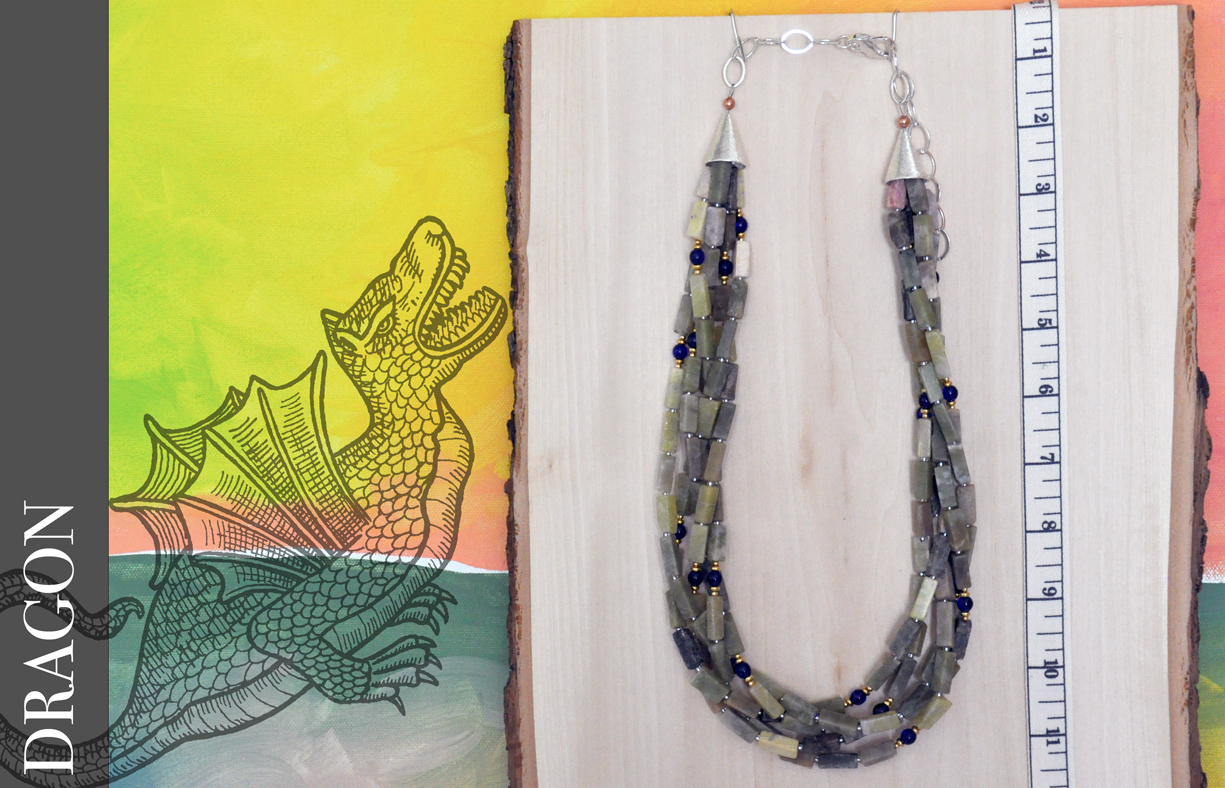
DRAGON. Multiple strands of dark olive green serpentine rectangles are like interlocking scales of that
fiery beast with brass beads bright among the stones. Serpentine is a kind of sheet silicate,
named for its resemblance to snakeskin.
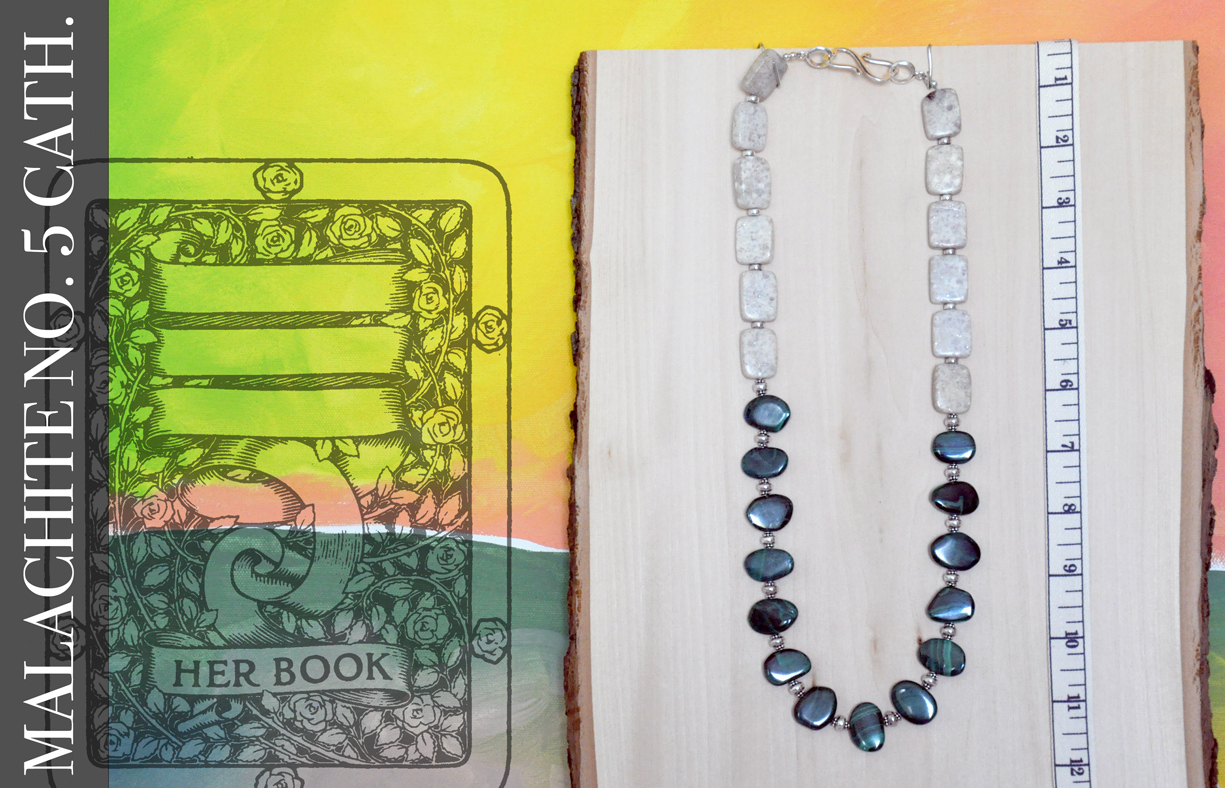
MALACHITE NO. 5 CATHER. Willa Cather traveled to the Southwest, which inspired short stories and portions of
novels like Song of the Lark. This necklace features glorious malachite freeform nuggets with sterling
silver accents and warm feldspar stone. Malachite is a copper carbonate hydroxide found in altered zones of
copper deposits, such as found in areas of Arizona and Mexico.
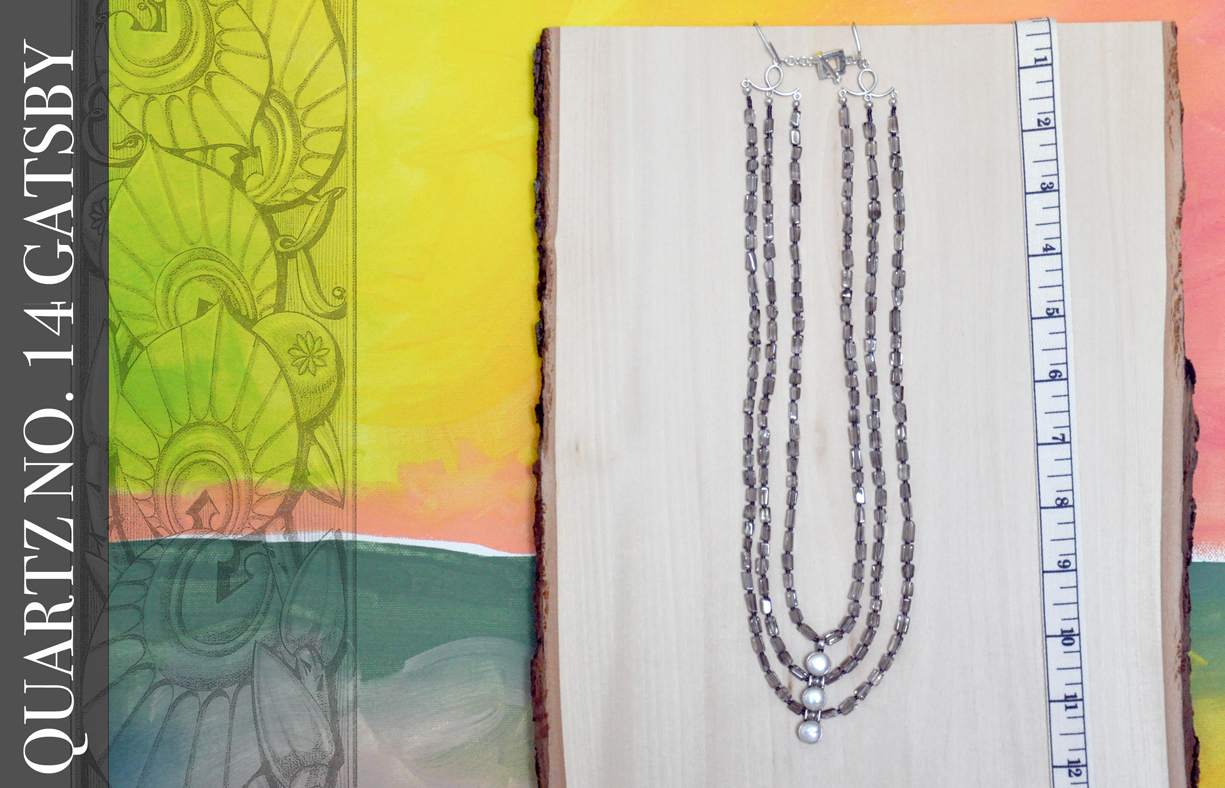
QUARTZ NO. 14 GATSBY. This triple strand smoky quartz gemstone necklace shines with flapper style, worthy
of those around the Great Gatsby. The center piece is a sterling silver pendant inset with pearls and holds
the gemstone strands.
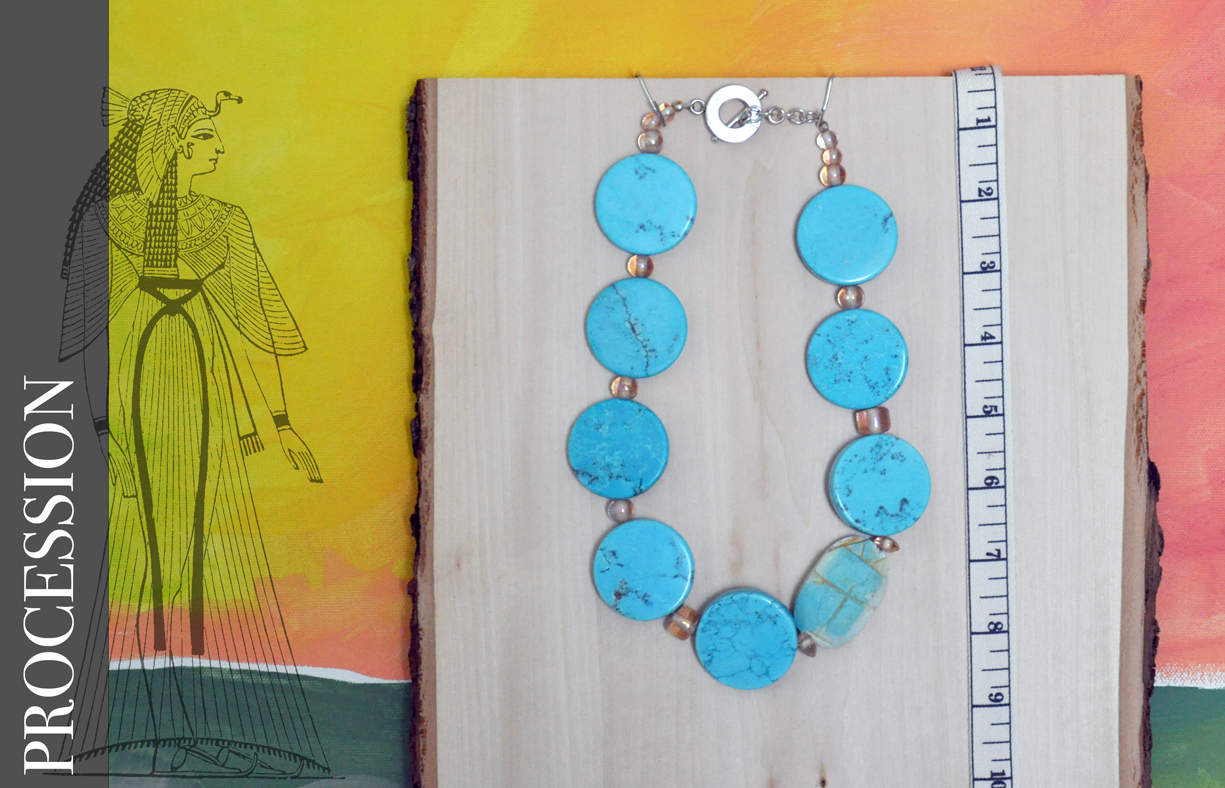
PROCESSION. Large chalk turquoise colored coins and a Dolomite marble scarab form the dramatic collar
for this necklace, suitable for a stately procession. Chalk turquoise often shows similar matrix to
turquoise but requires added color because of the lack of copper. Dolomite marble has a similar composition
to limestone though harder.
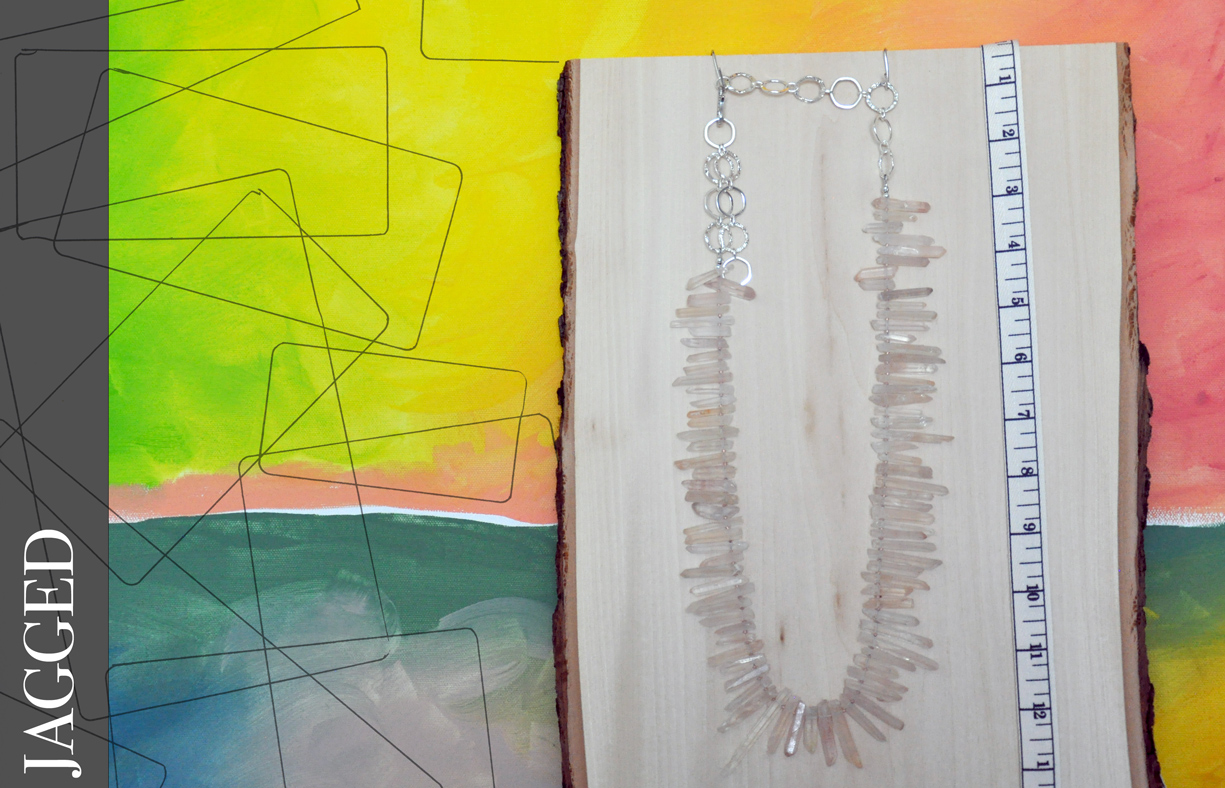
JAGGED. Natural quartz crystal points in pale shades of peach form this jagged necklace. The crystals are
approximately 1"-2" long and approximately 3/8" wide. Generally, quartz crystals are found
in igneous rocks, with larger crystals developing in magma containing more water and with faster cooling.
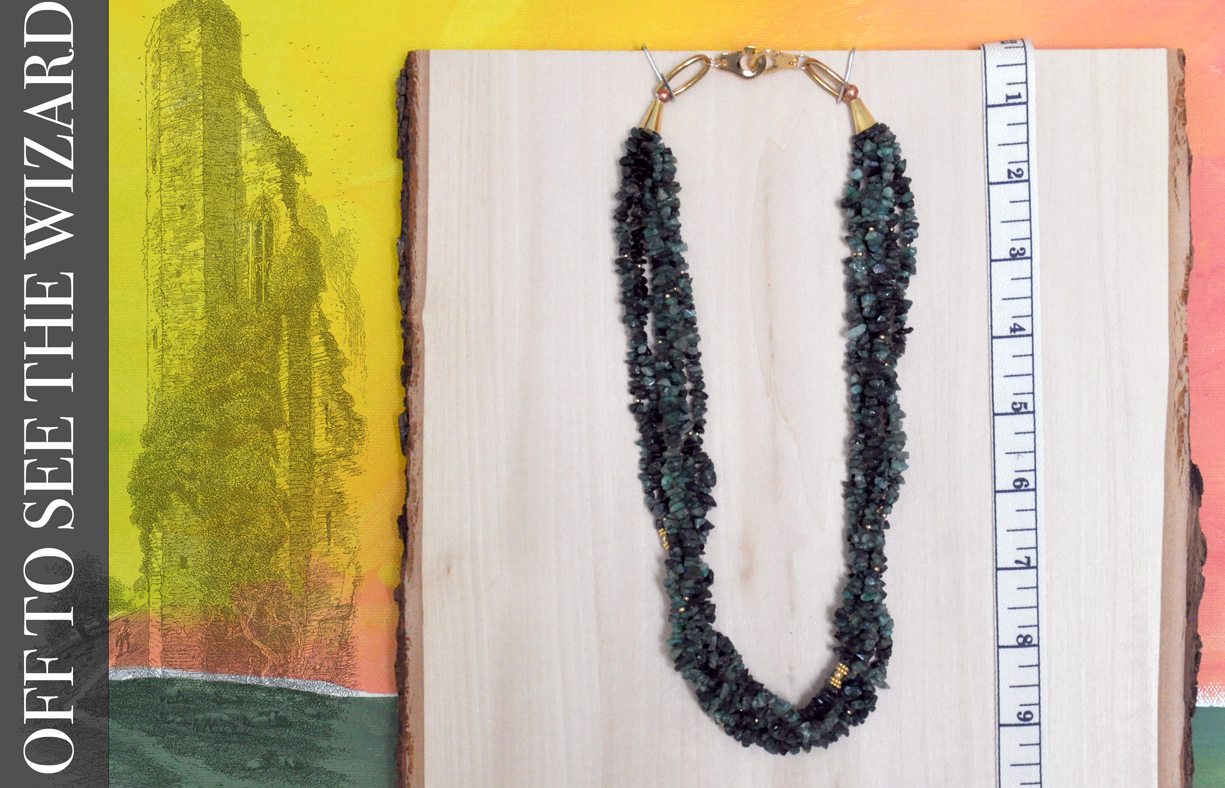
OFF TO SEE THE WIZARD. This necklace with multiple strands of emerald gemstone chips is perfect for a
trek to Emerald City to meet the famous wizard of Oz. L. Frank Baum's children's novel written in 1900 continues
to inspire movies and related stories.

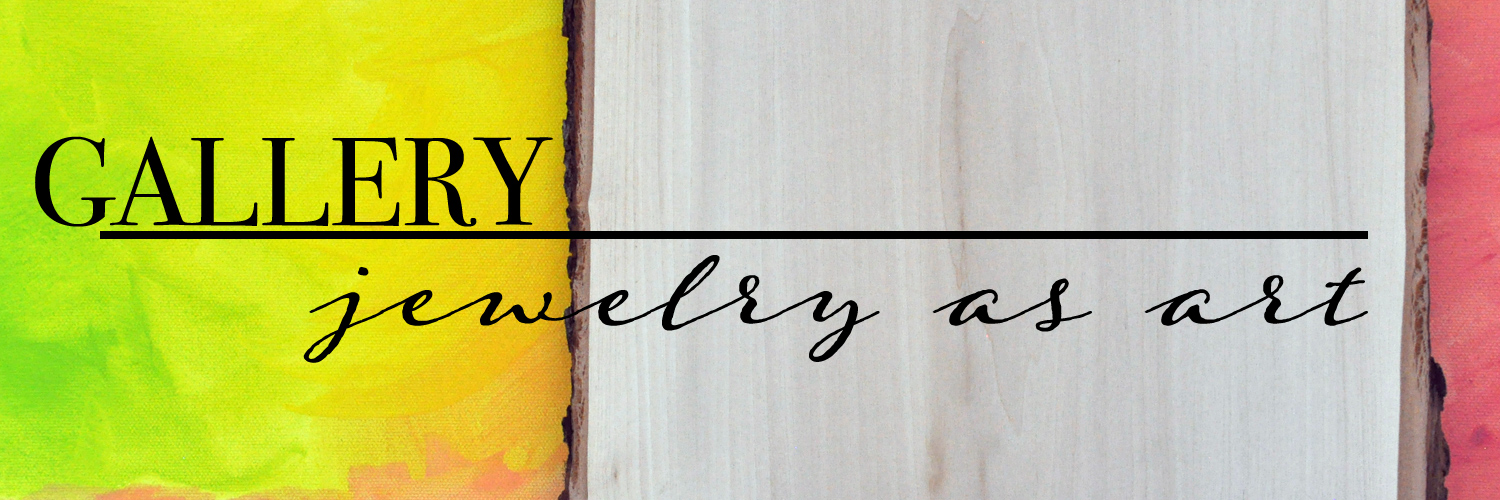 Take a walk through a gallery of wearable art. The jewelry items gathered here were selected for
qualities that make them more like artistic statements than simple accessories. These
qualities may be bold combinations of color, intriguing shapes, both, or something else
entirely. These pieces may not always be the easiest to wear, but they are generally the
most striking.
Take a walk through a gallery of wearable art. The jewelry items gathered here were selected for
qualities that make them more like artistic statements than simple accessories. These
qualities may be bold combinations of color, intriguing shapes, both, or something else
entirely. These pieces may not always be the easiest to wear, but they are generally the
most striking.  AMETRINE NO. 7 CARNARVON. Ametrine contains both amethyst and citrine, and the gemstones show intriguing transitions between the purple and
golden yellow colors of these gemstones. The large top-drilled rectangles in this necklace form a large,
gracious collar, much like ornaments depicted in Egyptian art. The English peer and aristocrat helped financed the famous
search and excavation of Tutankhamun's tomb in 1922.
AMETRINE NO. 7 CARNARVON. Ametrine contains both amethyst and citrine, and the gemstones show intriguing transitions between the purple and
golden yellow colors of these gemstones. The large top-drilled rectangles in this necklace form a large,
gracious collar, much like ornaments depicted in Egyptian art. The English peer and aristocrat helped financed the famous
search and excavation of Tutankhamun's tomb in 1922.
 FLUORITE NO. 3 MADAME BOVARY. The colors in this unusual necklace flow from lavender to icy teal blue to
deep purple, thanks to fluorite nuggets. This gemstone comes from the Latin word "fleure," which relates to
flowing out or continuous change. Madame Bovary might appreciate this bold design in her quest of a different
life, flowing with beauty and meaning.
FLUORITE NO. 3 MADAME BOVARY. The colors in this unusual necklace flow from lavender to icy teal blue to
deep purple, thanks to fluorite nuggets. This gemstone comes from the Latin word "fleure," which relates to
flowing out or continuous change. Madame Bovary might appreciate this bold design in her quest of a different
life, flowing with beauty and meaning.
 KUNZITE NO. 4 ROBIN GOODFELLOW. Kunzite is gem-quality pink to lavender spodumene, a lithium aluminosilicate. The intriguing
columnar crystals show the texture typical of the gemstone, and the errant patterns are like the energy from that
unpredictable Puck.
KUNZITE NO. 4 ROBIN GOODFELLOW. Kunzite is gem-quality pink to lavender spodumene, a lithium aluminosilicate. The intriguing
columnar crystals show the texture typical of the gemstone, and the errant patterns are like the energy from that
unpredictable Puck.
 COLUMN. Large sodalite gemstone coins with a central orange red moukaite coin form a decorative
collar circling the neck of the wearer. Stand stately like a column with this strong necklace trimmed with
gold.
COLUMN. Large sodalite gemstone coins with a central orange red moukaite coin form a decorative
collar circling the neck of the wearer. Stand stately like a column with this strong necklace trimmed with
gold.
 BUILDING BLOCKS. Each strand builds on the other in this colorful necklace with brightly colored furnace
glass and wooden beads. Furnace glass, or cane glass, refers to pieces created by pulling heated glass into
long uniform canes that contain the pattern within the original glass.
BUILDING BLOCKS. Each strand builds on the other in this colorful necklace with brightly colored furnace
glass and wooden beads. Furnace glass, or cane glass, refers to pieces created by pulling heated glass into
long uniform canes that contain the pattern within the original glass.
 IN THE NAME OF LOVE. Brightly painted wooden nuggets shimmer in this colorful necklace
celebrating all love. The wooden nuggets are plain hardwood from Asia, approximately 3/4"
in size.
IN THE NAME OF LOVE. Brightly painted wooden nuggets shimmer in this colorful necklace
celebrating all love. The wooden nuggets are plain hardwood from Asia, approximately 3/4"
in size.
 UNDERWATER. Large wooden round beads form the base of the artistic necklace featuring turquoise colored chalk
coins with flowing designs on watercolor paper. Chalk turquoise has similar composition to turquoise but lacks
copper, which gives turquoise its distinctive coloring. Generally, chalk turquoise from China is dyed and stabilized to
resemble turquoise.
UNDERWATER. Large wooden round beads form the base of the artistic necklace featuring turquoise colored chalk
coins with flowing designs on watercolor paper. Chalk turquoise has similar composition to turquoise but lacks
copper, which gives turquoise its distinctive coloring. Generally, chalk turquoise from China is dyed and stabilized to
resemble turquoise.
 DRAGON. Multiple strands of dark olive green serpentine rectangles are like interlocking scales of that
fiery beast with brass beads bright among the stones. Serpentine is a kind of sheet silicate,
named for its resemblance to snakeskin.
DRAGON. Multiple strands of dark olive green serpentine rectangles are like interlocking scales of that
fiery beast with brass beads bright among the stones. Serpentine is a kind of sheet silicate,
named for its resemblance to snakeskin.
 MALACHITE NO. 5 CATHER. Willa Cather traveled to the Southwest, which inspired short stories and portions of
novels like Song of the Lark. This necklace features glorious malachite freeform nuggets with sterling
silver accents and warm feldspar stone. Malachite is a copper carbonate hydroxide found in altered zones of
copper deposits, such as found in areas of Arizona and Mexico.
MALACHITE NO. 5 CATHER. Willa Cather traveled to the Southwest, which inspired short stories and portions of
novels like Song of the Lark. This necklace features glorious malachite freeform nuggets with sterling
silver accents and warm feldspar stone. Malachite is a copper carbonate hydroxide found in altered zones of
copper deposits, such as found in areas of Arizona and Mexico.
 QUARTZ NO. 14 GATSBY. This triple strand smoky quartz gemstone necklace shines with flapper style, worthy
of those around the Great Gatsby. The center piece is a sterling silver pendant inset with pearls and holds
the gemstone strands.
QUARTZ NO. 14 GATSBY. This triple strand smoky quartz gemstone necklace shines with flapper style, worthy
of those around the Great Gatsby. The center piece is a sterling silver pendant inset with pearls and holds
the gemstone strands.
 PROCESSION. Large chalk turquoise colored coins and a Dolomite marble scarab form the dramatic collar
for this necklace, suitable for a stately procession. Chalk turquoise often shows similar matrix to
turquoise but requires added color because of the lack of copper. Dolomite marble has a similar composition
to limestone though harder.
PROCESSION. Large chalk turquoise colored coins and a Dolomite marble scarab form the dramatic collar
for this necklace, suitable for a stately procession. Chalk turquoise often shows similar matrix to
turquoise but requires added color because of the lack of copper. Dolomite marble has a similar composition
to limestone though harder.
 JAGGED. Natural quartz crystal points in pale shades of peach form this jagged necklace. The crystals are
approximately 1"-2" long and approximately 3/8" wide. Generally, quartz crystals are found
in igneous rocks, with larger crystals developing in magma containing more water and with faster cooling.
JAGGED. Natural quartz crystal points in pale shades of peach form this jagged necklace. The crystals are
approximately 1"-2" long and approximately 3/8" wide. Generally, quartz crystals are found
in igneous rocks, with larger crystals developing in magma containing more water and with faster cooling.